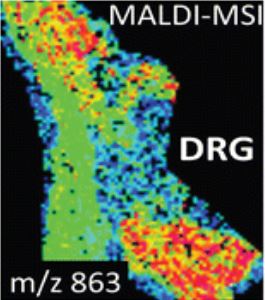 Stanislav S. Rubakhin, Alexander Ulanov and Jonathan V. Sweedler
Stanislav S. Rubakhin, Alexander Ulanov and Jonathan V. Sweedler
J Am Soc Mass Spectrom. 2015 Jun;26(6):958-66. Epub 2015 Mar 31.
Matrix-assisted laser desorption/ionization (MALDI) mass spectrometry imaging (MSI) has evolved to become an effective discovery tool in science and clinical diagnostics. Here, chemical imaging approaches are applied to well-defined regions of the mammalian peripheral sensory-motor system, including the dorsal root ganglia (DRG) and adjacent nerves. By combining several MSI approaches, analyte coverage is increased and 195 distinct molecular features are observed. Principal component analysis suggests three chemically different regions within the sensory-motor system, with the DRG and adjacent nerve regions being the most distinct. Investigation of these regions using gas chromatography-mass spectrometry corroborate these findings and reveal important metabolic markers related to the observed differences. The heterogeneity of the structurally, physiologically, and functionally connected regions demonstrates the intricate chemical and spatial regulation of their chemical composition.


No responses yet